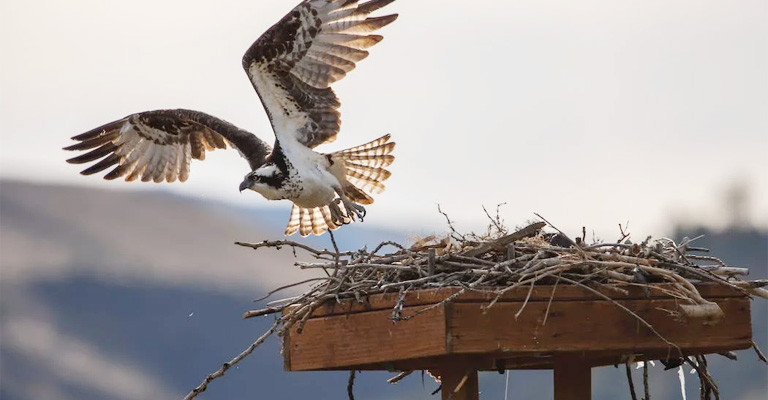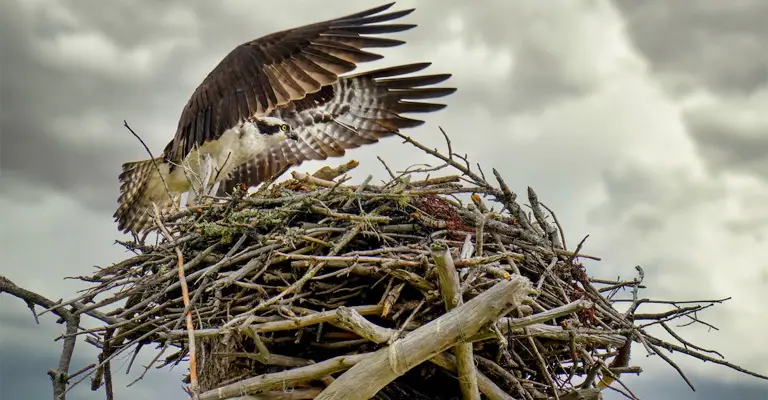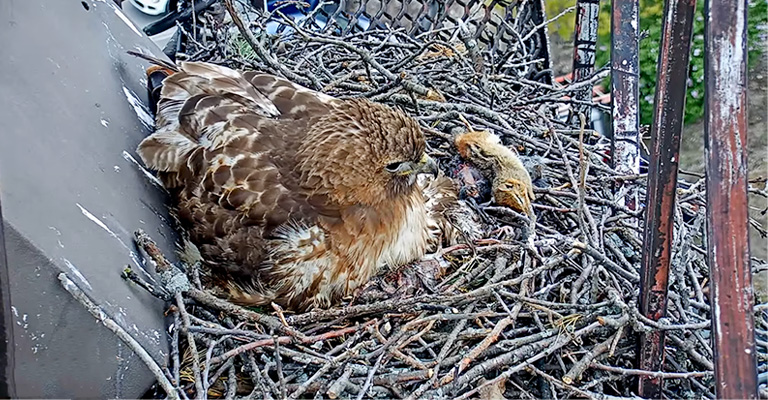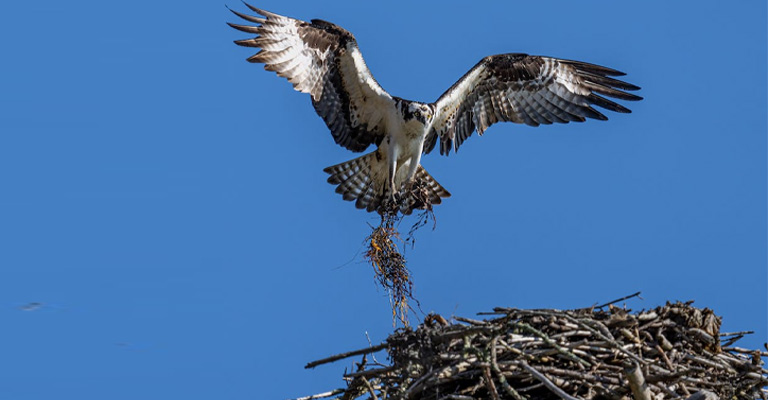The sight of a red-tailed hawk soaring gracefully through the sky is a breathtaking experience. With their distinct reddish-brown plumage and piercing eyes, these raptors command attention and awe. However, beyond their captivating flights, red-tailed hawks possess another remarkable aspect of their lives: nesting.
In this article, we will delve into the fascinating world of red-tailed hawks nesting, exploring their nesting habits, the intricacies of their nests, and the remarkable dedication they exhibit towards their offspring.

Red-Tailed Hawks Nesting
Some common aspects of red-tailed hawks nesting include:
Nest Selection and Construction
Red-tailed hawks are known for their resourcefulness when it comes to selecting nesting sites. They typically choose locations that provide safety, seclusion and a strategic vantage point for hunting.
Preferred nesting spots include tall trees, cliffs, and man-made structures such as power poles or abandoned buildings. Both urban and rural areas can serve as suitable habitats for these magnificent birds.
When it comes to nest construction, the red-tailed hawk demonstrates meticulous craftsmanship. The nests, known as aeries, are built primarily by the female hawk using twigs, sticks, and branches.
She weaves them together into a sturdy foundation, creating a circular structure lined with soft materials like leaves, grass, and sometimes even feathers.
Over the years, red-tailed hawks continue to add to and reinforce their nests, resulting in impressive structures that can reach several feet in diameter.
Breeding Season and Egg Incubation
Red-tailed hawks typically mate for life, forming a strong bond with their partner. Breeding season usually begins in late winter or early spring, and during this time, the hawks engage in elaborate courtship displays, including aerial acrobatics and territorial calls.
Once the pair has established a bond, the female lays one to five eggs, with an average clutch size of two to three eggs. The eggs are incubated primarily by the female while the male provides her with food.
Incubation typically lasts for about 28 to 35 days, during which time the female remains devoted to keeping the eggs warm and protected. This period of incubation showcases the nurturing side of these formidable birds.
Parental Care and Fledgling
After hatching, the young red-tailed hawks, known as eyasses, are initially helpless and rely entirely on their parents for nourishment and protection.
The female and male hawk take turns hunting and delivering prey to the nest, ensuring a steady supply of food for their growing chicks.
The eyasses quickly grow in size and strength, developing their iconic reddish tail feathers and sharp talons. Around six to seven weeks after hatching, the young hawks take their first flights from the nest, a phase known as fledging.
During this critical period, the parents continue to provide guidance, teaching their offspring essential hunting and survival skills. Fledging is a thrilling spectacle as the young hawks test their wings and embark on their journey toward independence.
Where Do Red-Tailed Hawks Nest?

Red-tailed hawks are highly adaptable when it comes to selecting nesting sites. They can be found in a variety of habitats, including forests, woodlands, deserts, grasslands, and even urban areas. Here are some common locations where red-tailed hawks choose to nest:
Trees
Red-tailed hawks often select tall trees with sturdy branches as nesting sites. They prefer trees that provide seclusion, safety, and a good vantage point for hunting. Species such as pines, oaks, and cottonwoods are frequently chosen for their nest construction.
Cliffs and Rocky Outcrops
In areas where suitable trees are scarce, red-tailed hawks may opt for nesting on cliffs or rocky outcrops. These elevated locations offer security from ground predators and a commanding view of their surroundings.
Power Poles and Communication Towers
In urban and suburban areas, red-tailed hawks have adapted to nest on man-made structures such as power poles, transmission towers, or communication towers. These structures mimic the height and seclusion provided by natural nest sites.
Abandoned Buildings
Old barns, warehouses, and other abandoned structures can become nesting sites for red-tailed hawks. These structures offer shelter and protection from the elements, as well as a secure place to raise their young.
It’s important to note that red-tailed hawks are protected under the Migratory Bird Treaty Act in the United States, which makes it illegal to disturb their nests or harm the birds.
If you happen to come across a red-tailed hawk nest, it is best to observe it from a respectful distance, allowing these magnificent birds to carry out their nesting activities undisturbed.
What Do Red-Tailed Hawk Nests Look Like?

Red-tailed hawk nests, known as aeries, exhibit distinct features that reflect the birds’ craftsmanship and dedication. Here are the notable characteristics of red-tailed hawk nests:
Size and Shape
Red-tailed hawk nests can vary in size depending on the materials accumulated over the years. They typically measure 2 to 3 feet (0.6 to 0.9 meters) in diameter, although larger nests have been recorded. The nest takes on a circular shape, resembling a platform or shallow bowl.
Construction Materials
The primary construction materials used by red-tailed hawks are twigs, sticks, and branches. The female hawk skillfully interweaves these materials to create a sturdy foundation.
The outer layer of the nest is composed of larger sticks, while the inner part is lined with finer materials such as leaves, grass, and occasionally feathers.
Height and Placement
Red-tailed hawk nests are typically positioned high above the ground to provide safety and a clear view of the surroundings. The nests can be found in tall trees, cliffs, or man-made structures like power poles and communication towers. The height of the nest can range from 20 to 80 feet (6 to 24 meters) above the ground.
Reuse and Expansion
Red-tailed hawks often reuse and expand their nests over multiple breeding seasons. The pair may return to the same nesting site year after year, adding new materials to strengthen the structure and accommodate growing offspring. This results in larger nests over time, with additional layers and extensions.
Soft Lining
To create a comfortable environment for their eggs and nestlings, red-tailed hawks line the inner part of the nest with softer materials. Leaves, grass, and sometimes feathers are carefully arranged to provide insulation and cushioning.
Camouflage
Red-tailed hawk nests are built with an emphasis on blending into their surroundings. The outer layer of sticks and branches is often intertwined with leaves or green foliage, helping the nest blend in with the surrounding vegetation and making it harder for predators to spot.
These remarkable nests showcase the red-tailed hawks’ ability to construct sturdy and well-insulated structures that meet the needs of their growing family.
Their careful selection of materials and strategic placement demonstrate their adaptability and resourcefulness in creating a safe haven for their young.
How Do Red-Tailed Hawks Build Their Nests?

Red-tailed hawks exhibit a methodical and intricate process when building their nests, known as aeries. The construction of these nests involves several stages, demonstrating the birds’ resourcefulness and attention to detail. Here is an overview of how red-tailed hawks build their nests:
Nest Site Selection
Red-tailed hawks begin by choosing a suitable nesting site. They prefer tall trees, cliffs, or man-made structures such as power poles or communication towers. The selected site offers security, seclusion, and a strategic vantage point for hunting and monitoring the surroundings.
Gathering Construction Materials
The female hawk takes the lead in nest construction while the male provides materials and support. They gather an assortment of twigs, sticks, and branches, typically breaking them off from nearby trees or shrubs.
The hawks might also reuse materials from previous nests, such as sticks left intact or intact portions of abandoned nests.
Framework Construction
The female hawk begins by building the framework of the nest. She intertwines and arranges larger sticks and branches, weaving them together to form a sturdy foundation. This initial structure provides stability and serves as the base for the nest.
Interior Lining
Once the framework is in place, the female hawk meticulously lines the nest’s interior. She incorporates softer materials like leaves, grass, and sometimes feathers, arranging them in a circular pattern to create a comfortable nesting chamber for the eggs and later the nestlings.
Nest Maintenance and Expansion
Red-tailed hawks continue to maintain and expand their nests over time. They may reinforce the nest by adding new sticks and branches, strengthening its structure. With each breeding season, the hawks incorporate additional materials, resulting in more substantial nests.
Camouflage and Protection
Red-tailed hawks employ camouflage techniques during the construction process. They strategically arrange sticks, leaves, and other materials to blend the nest with the surrounding vegetation. This helps conceal the nest from potential predators and reduces the chances of disturbance.
Throughout the nest-building process, red-tailed hawks exhibit remarkable precision and skill. Their ability to select suitable materials, construct a sturdy framework, and provide a comfortable interior showcases their instinctual knowledge of nest architecture.
By meticulously building and maintaining their nests, red-tailed hawks create secure and nurturing environments for their young, reflecting their commitment to successful reproduction and parenthood.
FAQs
Red-tailed hawks typically spend several weeks in their nests, from egg incubation to the fledging of their young. The exact duration varies, but incubation typically lasts around 28 to 35 days. After hatching, the nestlings remain in the nest for approximately six to seven weeks.
Red-tailed hawks prefer to nest at elevated locations that provide safety and a clear view of their surroundings. The height of their nests can vary but generally ranges from 20 to 80 feet (6 to 24 meters) above the ground.
Yes, red-tailed hawks often reuse and expand their nests over multiple breeding seasons. They may return to the same nesting site year after year, adding new materials to strengthen the structure and accommodate growing offspring. This reuse and expansion contribute to the impressive size and complexity of their nests over time.
Red-tailed hawks typically lay one to five eggs in a clutch, with an average clutch size of two to three eggs. The number of eggs can vary depending on factors such as the availability of food and the health of the parents.
Yes, red-tailed hawks are territorial and fiercely defend their nests from potential threats. When intruders, including other raptors or predators, approach their nesting area, red-tailed hawks display aggressive behaviors.
Final Words
Witnessing red-tailed hawks nesting is a captivating experience that offers a glimpse into the world of avian parenthood.
From their careful selection of nesting sites to their meticulous construction of aeries, these magnificent birds demonstrate an unwavering commitment to their young.
The red-tailed hawks’ breeding season, egg incubation, and subsequent parental care highlight the dedication and resilience required to raise the next generation.
As we marvel at the grandeur of red-tailed hawks in flight, let us also appreciate the intricate and profound bond they share with their offspring.
By understanding and celebrating their nesting habits, we deepen our appreciation for these majestic creatures and their remarkable contributions to the natural world.